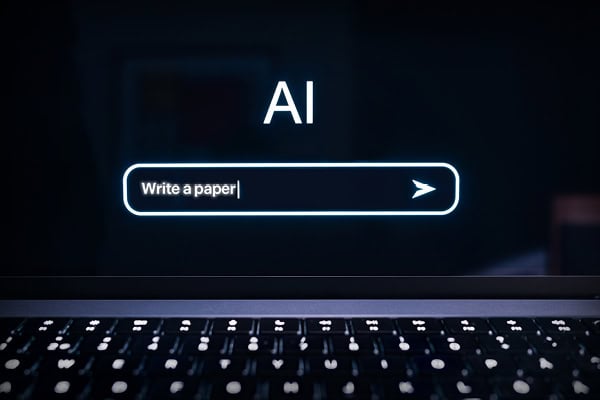When and how students can use AI appropriately is one of the major questions of the day, according to eSchool News. It takes only seconds to plug a writing prompt into a generative AI tool and receive a completed assignment. Instead of forbidding generative AI tools, it’s critical teachers show students how and when it’s appropriate to use AI in student writing.
Bottom line: When students are confident in their writing skills, they will be less tempted to run directly to AI to generate a writing assignment. Then, teachers can demonstrate how and when it’s appropriate for students to use AI to their benefit.
It’s generally easy to determine if students have used an AI tool to generate a response to a writing assignment or to generate an entire essay. The biggest tell is that the writing will sound nothing like any of the student’s other submitted assignments. Teachers can also look for:
- Flawless writing: The grammar is nearly error-free, and the longer the response, the more bloated sentences that repeat the same concept
- Lack of original/authentic thinking: AI can only compose what it finds on the internet
- Advanced language: Use of uncommon vocabulary terms when trying to write at a higher level, or using obvious casual language to tone it down
- Format and structure are traditional and robotic: Consider what a five-paragraph essay typically looks like when using an outline
- Use of lists or outlines: AI likes to create subtopics, label them, and then provide encyclopedia-type responses
Teachers should include an AI use chart with their course descriptions and have clear-cut discussions with parents and students about when AI use is and is not acceptable.
It’s important to identify and address the reasons students use AI to write. Those reasons may include lack of writing skills, insecurity around writing skills, struggles with time management, confusion about the topic, missing grammar and organizational skills, having no motivation or interest, missing real-world relevance, poor work ethic, lack of access to resources, and home/personal life stress.
It’s important to make the writing process less intimidating.
Accepting late work and allowing revisions can really determine if students use AI. If you’re not going to accept it late and they’re not going to have any time [to do the work], they’re going to go ahead and use AI.
Rethink the full-length essay as the end-all, be-all for assessing student writing skills. It’s intimidating. Assess their understanding of what they read and their ability to write through shorter bursts of writing
AI is not going away, so it’s worthwhile to identify the things AI can do in the writing classroom. AI can help personalize content for students based on their level of knowledge, learning speed, and desired learning goals; provide one-on-one learning experiences outside the classroom; give students quick responses to questions to save time; and serve as a 24/7 chatbot for learning to provide learning equity.
Creating assignments that require things AI is not good at is one way to circumvent widespread student AI use. For example, AI is good at conducting research, synthesizing information, using different levels of vocabulary, and adopting a particular tone. AI is not good at offering subjective explanations, evaluative critical thinking, sharing personal experiences, and offering personal reflections.
If you do suspect a student has submitted an assignment entirely generated from AI, approaching the issue carefully can ensure open conversations:
- Recognize your biases and don’t assume the student’s intention
- Come from a place of support rather than words/actions that shame the student
- Consider how much AI assistance was used to write the assignment
- If the piece is 100 percent AI, offer zero credit for that assignment and give the student an opportunity to rewrite it
It’s important to communicate with families about AI writing, too. Define what AI-generated writing is, provide a range of acceptable use of AI within your classroom, provide a discipline matrix showing actions for AI use violations, and emphasize that AI has some great tools to assist students with writing, but not in generation of entire assignments
Important considerations for classroom AI include:
- AI is here to stay–it’s a companion and helper, not a replacement for humans
- Revamp and revise your approach to teaching with AI in mind
- Try something new, like shorter bursts of writing and/or collaboration, to assess skills
- Train your students on how to use AI ethically–when is it appropriate to use AI?
- Work on helping students gain confidence in their writing
eSchool News





